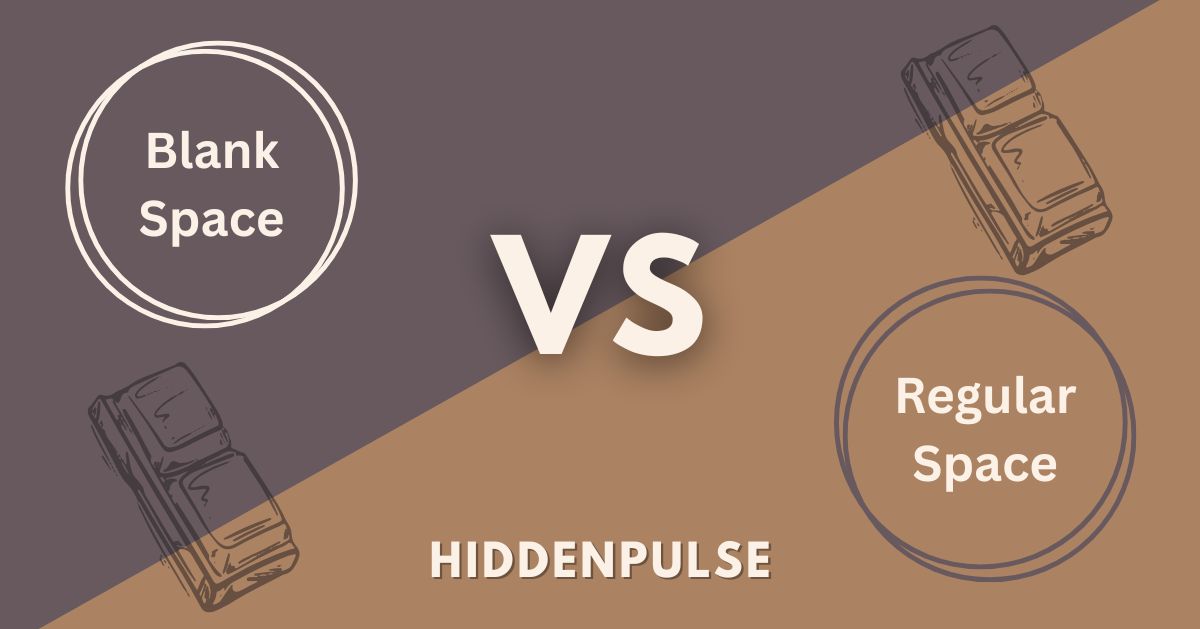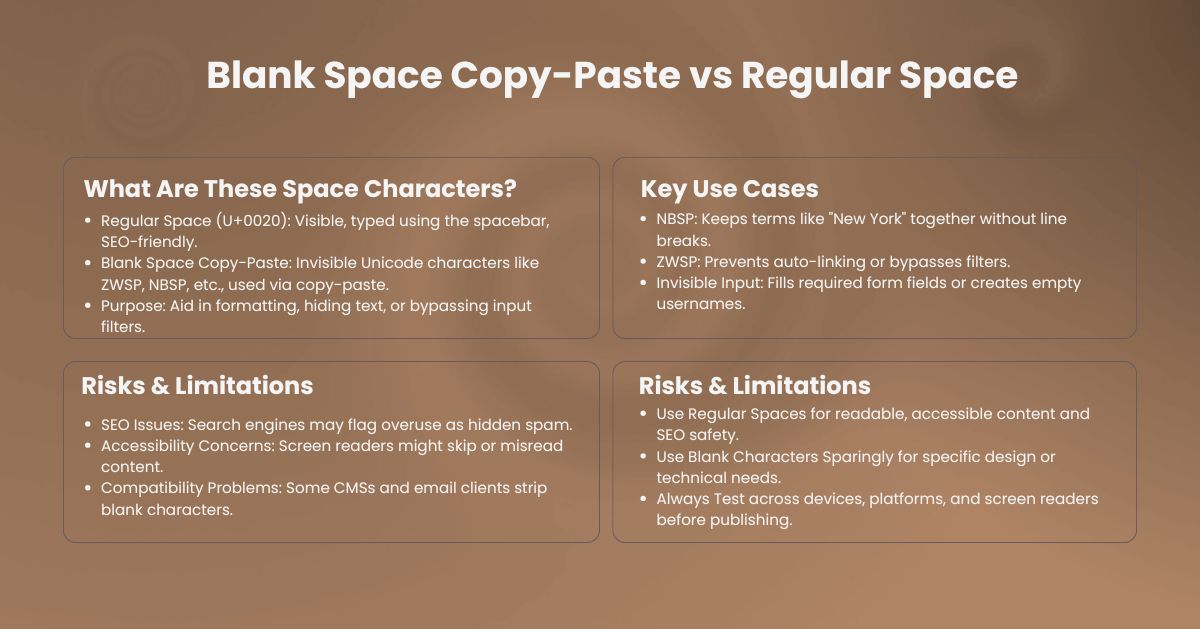Blank Space Copy-Paste vs Regular Space: What’s Better?

Introduction
It should be easy enough to use the spacebar to insert a space in everyday writing. However, space characters are not easy to use when formatting a webpage, creating content that is optimized for search engines, or creating user interfaces.
Invisible characters, such as copy-and-paste blank space characters, zero-width space, and non-breaking space, behave differently than regular spaces. These empty characters can be used to conceal hidden text, get around filters, and create formatting tricks.
Which is preferable, a blank space copy-paste character or a regular space? Let’s examine each in detail, including what it offers and when to use it.
What Is a Regular Space?
The regular space is the most familiar whitespace character. It’s what you type with your spacebar and what separates nearly every word you write. In Unicode, it’s encoded as U+0020.
Properties:
- Visible in all systems
- Interpreted correctly by search engines, screen readers, and browsers
- Breaks lines at word boundaries naturally
- Fully compatible across platforms (web, Word, PDF, etc.)
This is the default for all text-based applications and is a key component of natural language structure.
When to Use It:
- Standard writing (articles, emails, social media)
- Content creation (blog posts, product descriptions)
- When SEO and accessibility matter
What Is a Blank Space Copy-Paste Character?
Blank space copy-paste characters look like a space, or nothing at all, but act very differently. These characters are invisible or non-standard, and you can’t type them using your keyboard. Instead, you must copy and paste them from a generator or Unicode source.
Common Blank Characters:
- Zero-Width Space (ZWSP – U+200B): Appears as nothing but allows for word-breaking without visible space.
- Non-Breaking Space (NBSP – U+00A0): Looks like a regular space but doesn’t break onto a new line.
- Zero-Width Joiner/Non-Joiner (U+200D/U+200C): Used to control text rendering in complex scripts (e.g., Arabic, Hindi).
- Braille Blank (U+2800): A blank Braille pattern that renders some width but no visual character.
Why Use It?
- To format web or document layouts more precisely
- To insert invisible characters
- in usernames or bios
- To prevent unwanted line breaks
- To create hidden text for design or privacy reasons
- To copy and paste blank data into input fields that require a value
Regular Space vs Blank Space Copy-Paste
| Feature / Use Case | Regular Space (U+0020) | Blank Space Copy-Paste (ZWSP, NBSP, etc.) |
| Appearance | Visible gap between words | Invisible or extremely subtle |
| Typing Method | Spacebar | Must be copied and pasted |
| Unicode Examples | U+0020 | U+00A0, U+200B, U+200C, U+200D, U+2800 |
| Common Names | Space | empty space, blank copy paste, invisible character, etc. |
| SEO Impact | Safe, recommended | Risky if overused; may be seen as hidden text |
| Accessibility (Screen Readers) | Fully compatible | May confuse screen readers; can be skipped |
| Compatibility (CMS, Email, etc.) | 100% compatible | May be stripped or misinterpreted |
| Line Wrapping Control | Breaks at word boundary | NBSP prevents line breaks; ZWSP allows breaks without a visual gap |
| Use in Social Media / Usernames | Standard spacing | Creates invisible symbols or empty characters in display names |
| Visual Design Utility | Predictable spacing | Can be used for spacing tricks or invisible layout tweaks |
| Code & Programming Utility | No impact | Useful for layout hacks, hidden tokens, or zero-width formatting |
| Security & Anti-bot Measures | Easily detected | Can help disguise keywords or bypass filters |
| Ease of Editing | Easy to detect and delete | Hard to spot and remove without tools |
| Use in Invisible Captions/Metadata | Not used | Common in TikTok captions, bios, and alt-text SEO |
| Risk of Misuse | Low | High—copy and paste blank tricks may be flagged as spam |
| Should You Use It? | Yes, in most writing and SEO | Only for specific use cases—use sparingly and test compatibility |
How Copy-Paste Blank Characters Work in Practice
Let’s look at some practical examples where these characters shine.
1. Keep Phrases Together (NBSP)
Use a non-breaking space to keep terms like “New York” or “Monday 8:00 AM” from breaking across lines.
html
CopyEdit
<p>Meeting starts at 8:00 AM</p>
Benefit: Prevents unwanted layout shifts on mobile or in PDFs.
🕵️ 2. Hide Text from Bots (ZWSP)
Break a URL with a zero-width space to stop it from auto-linking.
arduino
CopyEdit
Visit: https://example.com
Effect: Humans can read it, but bots may not detect it.
3. Fill Empty Fields Invisibly
Some apps require input. Use a blank copy paste space to bypass the check without entering visible text.
Example: Add a ZWSP to a bio field that won’t allow it to remain empty.
Risks of Overusing Invisible Characters
While these blank characters seem magical, they come with real risks.
SEO Dangers:
Search engines may interpret invisible characters as spammy hidden text. If you try to manipulate keyword density using blank spaces, your site could be penalized.
Accessibility Challenges:
Screen readers might skip over these characters or announce them oddly, creating confusion for users relying on assistive technology.
Platform Compatibility:
Some CMSs and email clients strip out unknown Unicode characters. What looks fine in your editor may be broken or missing elsewhere.

Where Blank Characters Are Commonly Used
- TikTok/Instagram bios – Add clean line breaks or “empty” usernames
- Google Docs or Word – Control wrapping in complex tables
- HTML and CSS – Manage layout spacing and rendering
- JavaScript / Regex – Create test strings that include invisible characters
- Forms and bots – Fill required fields with invisible characters to bypass validation.
When Should You Use Each Type?
| Scenario | Recommended Space Character |
| Blog writing and SEO | Regular space (U+0020) |
| Web layout that avoids line breaks | NBSP (U+00A0) |
| Bypassing filters, bots, or spam checks | ZWSP or ZWNJ (use sparingly) |
| Creating invisible usernames or bios | Blank space copy-paste characters |
| Writing accessible content | Regular space only |
Copy-Paste Blank Generator Tips
To use blank copy and paste characters properly:
- Copy from a Unicode table or online generator (ZWSP, NBSP, etc.)
- Paste into your editor, form, or code block.
- Test it:
- In HTML view
- In plain text
- With screen readers or mobile devices
Pro Tip: Use comments or labels to mark where you’ve added invisible characters, or you may lose track.
Final Thoughts: Which Is Better?
There’s no one-size-fits-all answer.
- Use regular space when writing for humans and search engines.
- Use blank space copy-paste characters sparingly—for precise formatting, invisible text, or system bypasses.
Key Takeaways:
- Don’t overuse hidden spaces in SEO or you may get flagged
- Don’t rely on blank characters for critical layout—use HTML/CSS where possible
- Always test your invisible characters on multiple platforms and screen sizes
Summary
Whether you’re working on design, SEO, or accessibility, the space you use matters. While a blank space copy-paste character can solve niche problems, the regular space remains the most reliable option for clean, readable, and accessible content.
Use invisible characters wisely, and always choose clarity over cleverness.